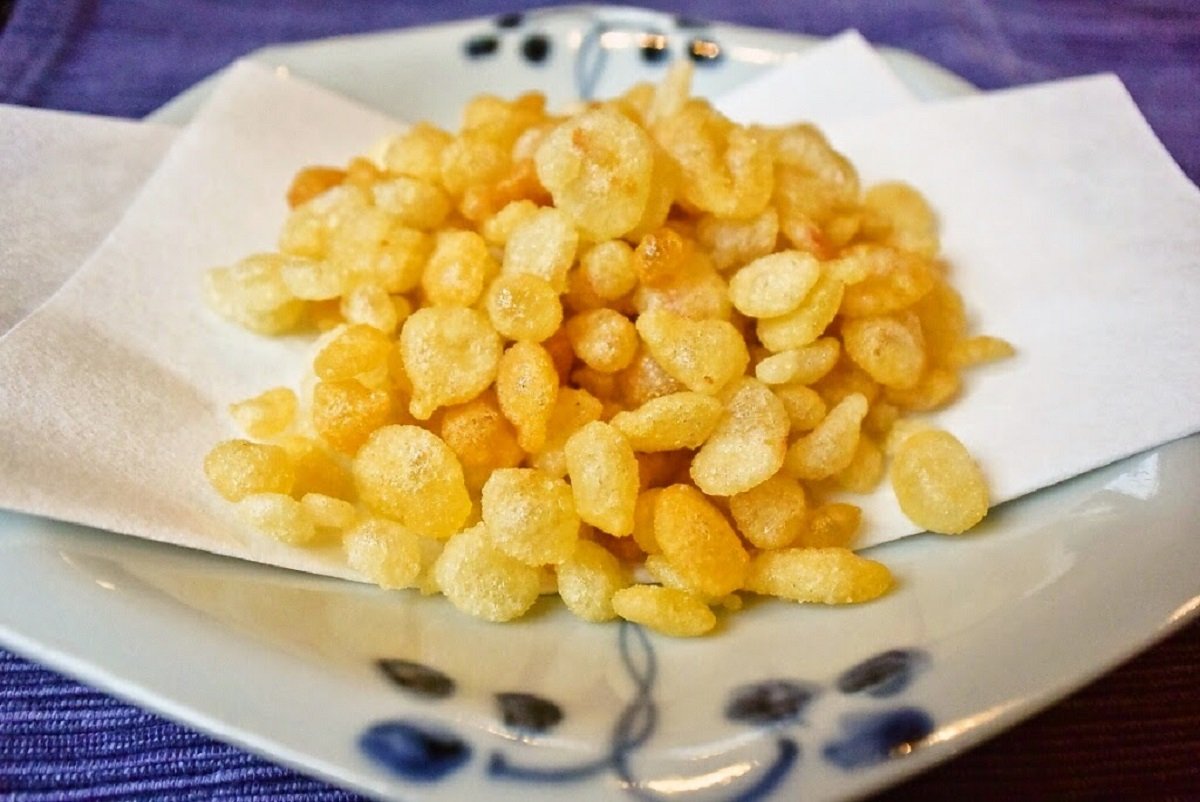When you think of Japanese cuisine, certain iconic foods may immediately come to mind sushi, tempura, ramen, and maybe even the ever-popular matcha. But for those who are truly immersed in the world of Japanese cooking, there are many lesser-known ingredients that bring depth and texture to the dishes. One such unsung hero is tenkasu. Although small in size, these crispy tempura bits pack a punch when it comes to flavor and texture, adding a delightful crunch to various dishes. In this article, we’ll take an in-depth look at tenkasu what it is, how it’s made, and how it’s used in Japanese cuisine, as well as some tips for trying it in your own home.
What is Tenkasu?
Tenkasu, often referred to as tempura flakes or crunchy bits, are small, crispy pieces of batter left over from making tempura. When tempura batter is deep-fried, it inevitably creates extra bits and fragments that fall away from the main pieces of tempura, such as shrimp, vegetables, or fish. These crispy bits are collected, dried, and stored as tenkasu.
The name “tenkasu” is a combination of “ten,” which refers to tempura, and “kasu,” meaning residue or scraps. While tenkasu may be viewed as a byproduct of tempura making, it has earned a significant place in Japanese cooking. In fact, many people create tenkasu specifically for its use as a crunchy topping or flavor enhancer in a variety of dishes.
The Origins of Tenkasu
Tempura was introduced to Japan by Portuguese missionaries in the 16th century. While the concept of deep-frying foods in batter was not new to the world, it was relatively novel in Japan at the time. Tempura quickly became a popular cooking method, and with it came the incidental creation of tenkasu.
Over time, Japanese cooks began to recognize the potential of these leftover tempura bits. Rather than discarding them, they started incorporating tenkasu into their dishes, particularly in street food and home-cooked meals. Tenkasu became a beloved addition to dishes such as okonomiyaki (savory pancakes) and takoyaki (octopus-filled dough balls), giving these foods an extra layer of texture and flavor.
How Tenkasu is Made
While tenkasu can be a byproduct of making tempura, it can also be made intentionally by frying small dollops of tempura batter in hot oil. The batter typically consists of flour, water, and sometimes an egg for added richness. When dropped into hot oil, the batter puffs up and becomes crispy as it fries. Once golden and crunchy, the tenkasu is removed from the oil and drained to remove excess grease.
Many supermarkets in Japan sell pre-made tenkasu, which is often packaged and ready to be sprinkled over dishes. However, homemade tenkasu is not difficult to make, and some cooks prefer to create their own for maximum freshness and control over the texture.
How to Use Tenkasu in Japanese Dishes
Despite being a simple ingredient, tenkasu plays an important role in various dishes, enhancing both texture and flavor. Its versatility and ability to absorb sauces make it a staple in many Japanese households. Here are a few traditional ways tenkasu is used:
1. Toppings for Noodles
One of the most common uses of tenkasu is as a topping for noodle dishes, particularly udon and soba. When sprinkled over a bowl of hot noodles, the crispy texture of tenkasu contrasts beautifully with the softness of the noodles and the warmth of the broth. Over time, the tenkasu absorbs the broth, becoming slightly soggy, which adds a different texture element to each bite. In tanuki soba or tanuki udon, a dish named after the mischievous Japanese raccoon-dog, tenkasu is the key ingredient that transforms plain noodles into something heartier and more flavorful.
2. Okonomiyaki and Takoyaki
Okonomiyaki and takoyaki are both savory dishes often made on street corners or at home in specialized pans. Which literally translates to “grilled as you like it,” is a thick, cabbage-based pancake that can be filled with ingredients like pork, seafood, or vegetables. Tenkasu is often added to the batter to give the pancake a light, crispy texture, balancing out the dense and chewy ingredients.
Similarly, takoyaki those famous round, doughy balls filled with pieces of octopus often include tenkasu mixed into the dough. This provides a pleasant crunch that contrasts with the gooey, molten interior of the ball.
3. Rice Dishes
Tenkasu is not just for noodles and pancakes it also shines as a topping for rice dishes. In tendon (tempura rice bowl), tenkasu is sometimes added to the rice or sprinkled over the top for extra texture. In addition, onigiri (rice balls) can be coated with tenkasu for a crispy outer layer, adding a crunchy surprise to every bite.
4. Soups
Beyond its use in solid dishes, tenkasu also finds its way into soups. It can be sprinkled into miso soup or clear broth soups to provide an added layer of richness and texture. Like in noodle dishes, tenkasu in soup gradually softens but still retains enough crispiness to make each spoonful more interesting.
Making Tenkasu at Home
Creating tenkasu at home is a straightforward process. Here’s a simple recipe for homemade tenkasu:
Ingredients:
- 1 cup all-purpose flour
- 1 egg (optional, for added richness)
- 1 cup cold water
- A pinch of salt
- Vegetable oil for frying
Instructions:
- In a bowl, mix the flour, egg, cold water, and salt to make a smooth batter. The batter should be runny, similar to pancake batter.
- Heat a pot of vegetable oil to around 350°F (175°C).
- Using a spoon or chopsticks, drop small amounts of the batter into the hot oil. The batter will puff up and turn golden brown as it fries.
- Remove the crispy bits with a slotted spoon and drain on paper towels to remove excess oil.
- Allow the tenkasu to cool completely before storing in an airtight container. It can be stored for up to a week, although it’s best enjoyed fresh.
Beyond Japanese Cuisine: Modern Uses of Tenkasu
As global fusion cuisine continues to evolve, tenkasu is finding its way into more international dishes. Chefs outside of Japan have started experimenting with tenkasu as a garnish for salads, pizzas, and even sandwiches. Its light, crispy texture works well with a wide variety of ingredients, and its neutral flavor profile makes it versatile enough to complement different types of cuisine.
For home cooks looking to try something new, sprinkling tenkasu over a Caesar salad or using it as a topping for a fish taco can add an exciting textural element. In addition, tenkasu can be used as a breadcrumb alternative for coating chicken or fish before frying, giving your dishes a unique crunch that’s lighter and airier than traditional breadcrumbs.
Conclusion
Tenkasu may seem like a humble ingredient, but it holds a special place in Japanese cuisine. From noodles to pancakes, rice bowls to soups, its crispy, crunchy texture enhances a wide variety of dishes. Whether you’re trying it as a topping for your favorite Japanese meal or experimenting with fusion cuisine, tenkasu is a versatile and delightful addition that’s sure to bring a little extra crunch to your plate. So the next time you make tempura, don’t let those crispy bits go to waste embrace the magic of tenkasu.











